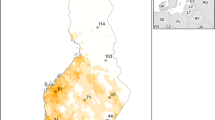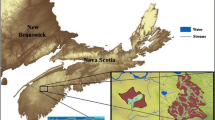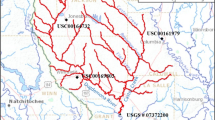Abstract
Water quality and unit nonpoint sources (NPS) pollution load from a forest area were studied in a mountainous watershed in Taiwan. The flow rates were measured with rectangular weirs and samples taken for water quality analysis in both non-rainy and rainy days for 2 years. The subroutine of the Hydrological Simulation Program – FORTRAN was used to simulate runoff for additional 3 years. Total annual loads of various water quality parameters were then estimated by a regression model. Most of the parameter concentrations are higher during the rainy days; their values are typically higher as compared to data from other undisturbed forest areas. Nevertheless, the concentration ratio of dissolved inorganic nitrogen to TN or \({\text{PO}}_4^{3 - } - {\text{P}}\) to TP shows TN or TP no correlations with the flow rates, whereas the concentrations of SS and TP are positively correlated with the flow rate. The fluctuation of annual load from this watershed is significant. For example, six major events of the entire year, for which the total duration is merely 6.4 days, contribute 42% of the annual precipitation and at least 40% of the annual NPS loads. The management for controlling the NPS pollution from this forest watershed is discussed.
Similar content being viewed by others
References
APHA (1998). Standard methods for the examination of water and wastewater (20nd ed.). Washington, DC: American Public Health Association.
Basnyat, P., Teeter, L., Lockaby, B. G., & Flynn, K. M. (2000). Land use characteristics and water quality: A methodology for valuing of forested buffers. Environmental Management, 26, 153–161.
Bicknell, B. R., Imhoff, J. C., Kittle, J. L., Jobes, T. H., & Donigian, A. S. (2001). HSPF version 12 user’s manual. Mountain View, California: Aqua Terra Consultants.
Brett, M. T., Arhonditsis, G. B., Mueller, S. E., Hartley, D. M., Frodge, J. D., & Funke, D. E. (2005). Non-point-source impacts on stream nutrient concentrations along a forest to urban gradient. Environmental Management, 35, 330–342.
Chang, C. H., Wen, C. G., Chuang, S. M., Lee, C. S., Chang, S. P., Wu, J. L., et al. (2004). Pollution and water quality evaluation for Tsengwen Reservoir. Paper presented at the 2004 World Water & Environmental Resources Congress, Salt Lake City, Utah.
Chen, J. S., & Chiu, C. Y. (2000). Effect of topography on the composition of soil organic substances in a perhumid sub-tropical montane forest ecosystem in Taiwan. Geoderma, 96, 19–30.
Clark, G. M., Mueller, D. K., & Mast, M. A. (2000). Nutrient concentrations and yields in undeveloped stream basins of the United States. Journal of the American Water Resources Association, 36, 849–860.
Correll, D. L., Jordan, T. E., & Weller, D. E. (1999). Precipitation effects on sediment and associated nutrient discharges from Rhode River watersheds. Journal of Environmental Quality, 28, 1897–1907.
Cotler, H., & Ortega-Larrocea, M. P. (2006). Effects of land use on soil erosion in a tropical dry forest ecosystem, Chemila watershed, Mexico. Catena, 65, 107–117.
Dadson, S. J., Hovius, N., Chen, H. G., Dade, W. B., Hsieh, M. L., Willett, S. D., et al. (2003). Links between erosion, runoff variability and seismicity in the Taiwan orogen. Nature, 426, 648–651.
Dillon, P. J., & Kirchner, W. B. (1975). The effects of geology and land use on the export of phosphorous from watershed. Water Research, 9, 135–148.
Edwards, P. J., & Stuart, G. W. (2002). State survey of silviculture nonpoint source programs: A comparison of the 2000 northeastern and national results. Northern Journal of Applied Forestry, 19, 122–127.
Edwards, P. J., Williard, K. W. J., & Kochenderfer, J. N. (2004). Sampling considerations for establishment of baseline loadings from forested watersheds for TMDL application. Environmental Monitoring and Assessment, 98, 201–223.
Evans, B. M., Sheeder, S. A., & Lehning, D. W. (2003). A spatial technique for estimating streambank erosion based on watershed characteristics. Journal of Spatial Hydrology, 3, 1–13.
Filoso, S., Vallino, J., Hopkinson, C., Rastetter, E., & Claessens, L. (2004). Modeling nitrogen transport in the Ipswich River Basin, Massachusetts, using a hydrological simulation program in Fortran (HSPF). Journal of the American Water Resources Association, 40, 1365–1384.
Fowler, J. M., & Heady, E. O. (1981). Suspended sediment production potential on undistributed forest land. Journal of Soil and Water Conservation, 36, 47–49.
Grace, J. M. (2002). Overview of best management practices related to forest roads: The southern states. Paper presented at the 2002 ASAE Annual Meeting, St. Joseph, Michigan.
Grace, J. M. (2004). Soil erosion following forest operations in the Southern Pledmont of central Alabama. Journal of Soil and Water Conservation, 59, 160–166.
Grace, J. M. (2005). Forest operations and water quality in the South. Transactions of the ASAE, 48, 871–880.
Grobler, D. C., & Silberbauer, M. J. (1985). The combined effect of geology, phosphate sources and runoff on phosphate export from drainage basins. Water Research, 19, 975–981.
Guo, L. B., & Sims, R. E. H. (1999). Litter decomposition and nutrient release via litter decomposition in New Zealand eucalypt short rotation forests. Agriculture Ecosystems & Environment, 75, 133–140.
Hovius, N., Stark, C. P., Chu, H. T., & Lin, J. C. (2000). Supply and removal of sediment in a landslide-dominated mountain belt: Central Range, Taiwan. Journal of Geology, 108, 73–89.
Huang, C. H. (2004). Use of HSPF model to simulate the nonpoint source pollution loads attributed to fertilization behaviors in a reservoir watershed. Dissertation, National Cheng Kung University (in Chinese).
Jan, C. D., Chang, C. J., & Lee, M. H. (2006a). Discussion of “Design and calibration of a compound sharp-crested weir” by J. Martinez, J. Reca, M. T. Morillas, and J. G. Lopez. Journal of Hydraulic Engineering-ASCE, 132, 868–871.
Jan, C. D., Tseng, C. M., Wang, J. S., & Cheng, Y. H. (2006b). Empirical relation between the typhoon surge deviation and the corresponding typhoon characteristics: A case study in Taiwan. Journal of Marine Science and Technology, 11, 193–200.
Kawara, O., Hirayma, K., & Kunimatsu, T. (1996). A study on pollution loads from the forest and rice paddy fields. Water Science and Technology, 33, 159–165.
Kusumandari, A., & Mitchell, B. (1997). Soil erosion and sediment yield in forest and agroforestry areas in West Java, Indonesia. Journal of Soil and Water Conservation, 52, 376–380.
Li, X., Ambrose, R. B., & Araujo, R. (2004). Modeling mineral nitrogen export from a forest terrestrial ecosystem to streams. Transactions of the ASAE, 47, 727–739.
Li, Z. A., Zou, B., Xia, H. P., Ren, H., Mo, J. M., & Weng, H. (2005). Litterfall dynamics of an evergreen broadleaf forest and a pine forest in the subtropical region of China. Forest Science, 51, 608–615.
Lodhiyal, N., & Lodhiyal, L. S. (2003). Aspects of nutrient cycling and nutrient use pattern of Bhabar Shisham forests in central Himalaya, India. Forest Ecology and Management, 176, 237–252.
Martinez, J., Reca, J., Morillas, M. T., & Lopez, J. G. (2005). Design and calibration of a compound sharp-crested weir. Journal of Hydraulic Engineering-ASCE, 131, 112–116.
National Research Council (NRC) (2001). Assessing the TMDL approach to water quality management. Washington, DC: National Academy.
Ongley, E. D. (2004). Non-point source water pollution in China: Current status and future prospects. Water International, 29, 299–306.
Qin, B. Q., Xu, P. Z., Wu, Q. L., Luo, L. C., & Zhang, Y. L. (2007). Environmental issues of Lake Taihu, China. Hydrobiologia, 581, 3–14.
Ritter, M. E. (2006). The physical environment: An introduction to physical geography. Retrieved June 18, 2007, from http://www.uwsp.edu/geo/faculty/ritter/geog101/textbook/title_page.html.
Sidle, R. C., Ziegler, A. D., Negishi, J. N., Nik, A. R., Siew, R., & Turkelboom, F. (2006). Erosion processes in steep terrain – Truths, myths, and uncertainties related to forest management in Southeast Asia. Forest Ecology and Management, 224, 199–225.
Stuart, G. W., & Edwards, P. J. (2006). Concepts about forests and water. Northern Journal of Applied Forestry, 23, 11–19.
Taiwan’s Central Weather Bureau (TWCWB) (2007). Daily rainfall records of A-Li Mountain Weather Station. Retrieved April 20, 2007, from http://www.cwb.gov.tw/V5/climate/statistic/Data/daily_rain/4675302004.htm (in Chinese).
Umemoto, S., Komai, Y., & Inoue, T. (2001). Runoff characteristics of nutrients in the forest streams in Hyogo Prefecture, Japan. Water Science and Technology, 44, 151–156.
US Environmental Protection Agency (USEPA) (2000a). BASINS technical note 6: Estimating hydrology and hydraulic parameters for HSPF (EPA-823-R00-012). Retrieved August 15, 2000, from http://www.epa.gov/waterscience/basins/tecnote6.pdf.
US Environmental Protection Agency (USEPA) (2000b). Metals TMDL for Little Kanawha River Watershed, West Virginia. Retrieved May 15, 2007, from http://www.epa.gov/reg3wapd/tmdl/wv_tmdl/LittleKanwahaRiver/2980_LittleKanawhaR_TMDL.pdf.
US Environmental Protection Agency (USEPA) (2005). National management measures to control nonpoint source pollution from forestry (EPA-841-B-05-001). Retrieved May 15, 2007, from http://www.epa.gov/nps/forestrymgmt/.
US Environmental Protection Agency (USEPA) (2007). Better assessment science integrating point & nonpoint sources. Retrieved August 31, 2007, from http://www.epa.gov/waterscience/basins/basinsv3.htm.
Wang, P., Linker, L., & Eshleman, K. (2003). Dynamic parameterization to simulate DIN export due to gypsy moth defoliation. Paper presented at the 2003 International Conference on Computational Science, Melbourne, Australia.
Wen, C. G., Kuo, J. T., Chang, S. P., Lee, C. S., & Chuang, S. M. (2001). Tsengwen Reservoir water quality investigation and improvement (1st Year). Tainan, Taiwan: Water Resources Agency (in Chinese).
Yan, M., & Kahawita, R. (2007). Simulating the evolution of non-point source pollutants in a shallow water environment. Chemosphere, 67, 879–885.
Author information
Authors and Affiliations
Corresponding author
Rights and permissions
About this article
Cite this article
Chang, CH., Wen, CG., Huang, CH. et al. Nonpoint source pollution loading from an undistributed tropic forest area. Environ Monit Assess 146, 113–126 (2008). https://doi.org/10.1007/s10661-007-0064-x
Received:
Accepted:
Published:
Issue Date:
DOI: https://doi.org/10.1007/s10661-007-0064-x




